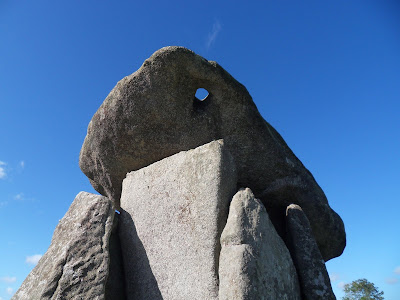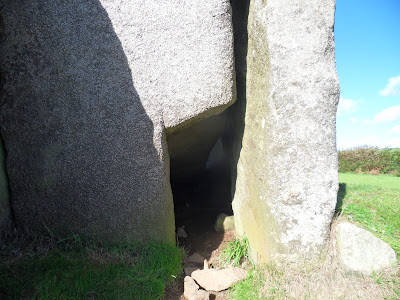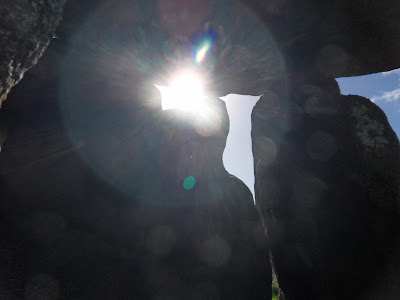
I'm featuring one of the mysteries of Cornwall again today. I live in Cornwall, England and this post is about the Mystery of the Trevethy Quoit Stones.
Part of the mystery of this ancient monument is the fact that even the experts can't be absolutely sure as to why the stones were erected in this particular way. The debate takes place because of their age. Estimates put this at around 3500BC. Though I did see one report that dated them even further back to 6000BC. But, whatever, they are definitely 5000 years old, which puts them on a par with the likes of the much more famous Stonehenge.
The seven granite slabs, which make up the structure are seriously heavy, the capstone is reckoned to be in the region of 10.5 tons. If we look at this top stone, in the two photos below, it can be seen that there is a hole.

The reason for the hole is unknown. Some say it may have been used for astrological reasons, but in the 1600s locals used it to hold a flagpole. So was the hole created thousands of years ago or much later? For some reason it always makes me think of an elephant!

The views so far are from the east. If we stay in this position it can be seen that at the bottom of the large upright stone, to the right hand side, there is an opening which could have been used as access to the inner part of the quoit.

I guess before we move on we should discuss as to why Trevethy Quoit may have been built.
If erected around 3500BC this would be during the Neolithic period. At this time there were known to be people living in the area and it was at a time when there would have been some of the first farmers. In fact the Parish of St Cleer, which encompasses Trevethy Quoit, is believed to have been inhabited from 6000BC.
The 'experts' seem to think it was a burial chamber and initially the structure would have been covered by more soil and stones - so from a distance it would appear as a mound. However local enthusiasts are certain that the monument would not have been completely covered.
Popular theories put forward for the purpose of Trevethy Quoit include:
(1) To hold the bones of the dead.
(2) To mark communal territory.
(3) As a gathering place.
(4) For ritual and ceremonial life for the local community.
If we move round to the south of this ancient monument, this is what we see:

The above photo also shows part of the west side of the structure. In 1850 the large west stone collapsed inwards and this can be seen more clearly from the pic below.

It can be seen that on this west stone there are a series of holes or indentations, probably seen clearer in the next photo:

So what are these holes or marks? A popular theory is that these are Midsummer Merriment Holes made perhaps in the middle ages. A young man of the day would have filled such a hole with an explosive which he would have then lit to proclaim his love for a sweetheart.
The next photo is one I took of the inside of the chamber which has a strange effect, presumably made by the sun.

I'll finish off with a few more photos of the granite rocks:

I always think that the stone to the left of the picture immediately below has a touch of the Easter Island about it.


Directions: To visit Trevethy Quoit go to the town of Liskeard, Cornwall and from here follow signs to St Cleer. When approaching village you will see a sign to Darite - follow this. It's now a narrow road but keep following this until you see sign post to Trevethy Quoit. There is car parking for about 5-6 cars only. It's free to view.
Other Cornish Posts:
The Cornish Mystery Of The Men-an-Tol Stones
Small Coincidences At Pentewan, Cornwall
The Cornish Mystery Of Morgawr Monster Of The Seas

like your cornish posts. i haven't heard of trevethy quoits before. somewhere else for me to visit when next in cornwall. amazing to think they were erected over 5000 years ago.
ReplyDeleteArrived here from Before Its News. I like your blog, you have some interesting posts. Especially like this and your Men-an-Tol stones article. I live near Stonehenge so I love ancient stones!
ReplyDeleteD
These are fantastic. Great pics, too. They really give a sense of the utter strangeness and mystery of this place.
ReplyDeleteStones of the Nephilim St. Cleer Bodmin Moor
ReplyDeleteStones of the Nephilim are a reminder to the living that this giant will never trouble the people of this place ever again.
williambolitho.blogspot.com
Having read Paul Devereux's book Places of Power, I am keenly aware of Trevethy Quoit and the many dolmens of Cornwall. Fascinating, little-known aspect of our history!
ReplyDeleteI agree with Billy - stones of the Nephilim.
ReplyDeleteI grew up in darite and spent many an hour as a child playing here, these pictures bring back some amazing memories for me.
ReplyDelete